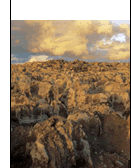|
The
Environment and Oberlin: An Update
Page
3
Education,
Research, and Outreach
If
the Lewis Center is intended to be a “building that teaches,”
then a key measure of its success should be the learning opportunities
it provides students. Already, the building and its landscape have
proved their value as a hands-on laboratory for studying the principles
of ecological design across disciplines, from biology to dance and
from economics to computer science and math. Last fall we introduced
a practicum that focuses entirely on the Lewis Center as a medium
to study ecological design. The building has become the topic of
private readings, summer fellowships and winter-term and work-study
projects. I supervised eight independent student projects last semester
on the data monitoring system and Living Machine, and I am currently
supervising five summer research fellows engaged in building-related
projects.
For
upper-level students, the Lewis Center offers unique opportunities
for researching ecological technologies. Honors students, for instance,
are working with me to develop a new technique for monitoring whole
ecosystem metabolism in the Living Machine and to test hypotheses
regarding the effect of plant growth on patterns of water flow in
the marsh. Finally, the data-gathered by the monitoring system mentioned
earlier represents an investment that will allow generations of
students to assess the long-term evolution in the performance of
buildings and landscapes as integrated ecological systems—the
kind of research opportunity reserved normally for graduate-level
study.
In addition to its value for Oberlin students, the Lewis Center
increasingly serves as a nexus and inspiration for local, regional,
and national dialogue on key environmental issues. More than 8,000
visitors have toured the facility in the last two years.
Organizations
ranging from the National Science Foundation to the Institute for
Ecological Economics have funded workshops hosted here. The Lewis
Center has also catalyzed the creation of several regional groups,
including the Cleveland Green Building Coalition, the Ecological
Design Innovation Center, and the Oberlin Design Initiative. These
organizations are applying principles of ecological design to architecture,
urban planning, and sustainable agriculture across northeast Ohio.
It is quite possible that the future of architecture in Cleveland,
farming in Lorain County, and development in downtown Oberlin will
be tangibly different as a result of lessons learned at Oberlin’s
innovative facility.
Judging
the success of a project with such ambitious and diverse goals requires
sophisticated and multifaceted analysis. The data that I have shared
here indicate that the center has already achieved a wide range
of objectives. But it is important to remember that the Lewis Center
will always be a work in progress; long-term success is contingent
upon the voracity with which we pursue opportunities for minimizing
energy and material use and for maximizing educational potential.
And as important as performance statistics may be, equally important
are the experiences of James McConaghie and others for whom safe
and healthy environments are often out of reach.
Go
To Page 1 | 2
| 3 | 4
|5 of Paradise for Sale
|







